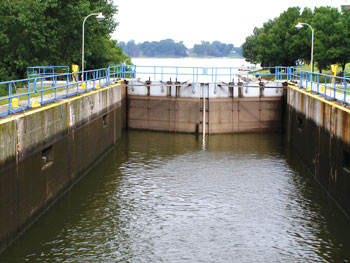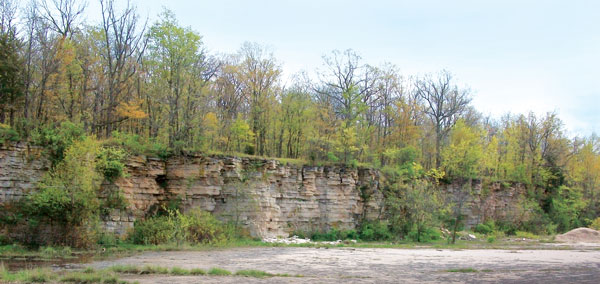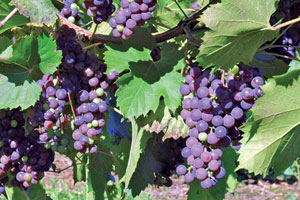Rocks, Roots and Revenue
We are all enchanted by Wisconsin’s natural beauty and excited by its abundance of recreational opportunities. Whether enjoying the view of a sparkling blue lake, cascading waterfall or rocky bluff, did you ever stop to think about why that feature is there? Why is the bluff in one place and not in another, or why do we have so many lakes in the state, or why is that river there, not here? Simply stated, did you ever just wonder why Wisconsin looks the way it does? You’re not alone.

Frances Anne Hopkins’ “Going Up the Rapids” painting depicts what it may have been like for early settlers to have to portage around the rapids of the Fox River.
A desire to understand our surroundings is basic to human nature. Understanding the landscape begins with learning about the geologic processes that shape the Earth and demonstrates that those rocks, hills and rivers are where they are for very specific reasons. Even the fact that we are America’s Dairyland has a geologic basis. Realizing that the rocks are more than just a backdrop to the scenery makes us wonder how they may have influenced the rest of nature and, ultimately, our history and culture.
Geotourism and Storytelling
This interest in understanding the landscape and all things connected to it has sparked a popular new trend in travel called, geotourism. This kind of tourism integrates the many aspects of nature and culture related to geology, giving travelers a more interesting and in-depth view of a region. In effect, geology, being the one feature that makes a location unique, is the “brand.” All of these various characteristics in combination invoke a sense of place, which harmonizes the human experience and the landscape for both the visitor and the local community. An important added benefit of the understanding that is engendered by geotourism is that it leads to a greater appreciation of natural, historical and cultural features, which helps ensure their preservation.

The Fox River locks play an important roll in the area’s geotourism attraction. Photo courtesy of Joanne Kluessendorf.
Travelers interested in geotourism make up a large market that includes anyone looking to experience all the unique and authentic qualities that a place has to offer: culture, history, archaeology and nature. Being better educated, geotourists tend to take more trips, and they spend more time and money at a destination. They want hands-on, fun and educational opportunities that are genuine and uniquely available at a destination. They are not interested in the cookie-cutter, franchised, mass-produced, one-size-fits-all experiences of typical tourist spots that have commonly sacrificed their distinctive attributes. In contrast, geotourism enhances the natural and cultural distinctiveness of a destination while providing a high-quality experience for both visitors and locals. Essentially, creating a geotourism theme for a region is all about storytelling; the more chapters that can be included, the more chances there are to engage a greater number and diversity of travelers. Providing context to these travelers not only enriches their experiences and adds value to their vacations, but, notably, it expands opportunities for entrepreneurship to boost local economies.
Pam Seidl, executive director of the Fox Cities Convention & Visitors Bureau, notes, “The trend in tourism is toward a ‘real’ visitor experience. Visitors want the authentic and they want to be hands on. The geology of a destination certainly is part of this authentic experience and attracts visitors interested in the natural landscape of an area. Visitors often ask about the Fox River and Lake Winnebago and how they can experience our abundant water resources.”
Examples of Geotourism
So what does any of this have to do with the Fox Cities region? Everything. Northeastern Wisconsin is fortunate to have fascinating geological and cultural histories that are ideal for putting the geotourism concept into action.
The river that runs through the Fox Cities is an excellent candidate for the geotourism approach. Because of its complex geological history, the Fox River is punctuated by major rock rapids. These rapids impeded the journeys of French fur trappers and Native Americans, but they were a welcome sight to early settlers who harnessed their power for gristmills. As towns took root along the river, the rapids afforded the waterpower to create the largest concentration of paper mills in the world as the nearby North Woods were logged over. To outfox the rapids, a series of locks was built along the river, which remains popular with boaters today. And, as technology progressed, the rapids produced the first hydroelectric power generated by a central power station in the world. In this manner, the geological processes that produced the Fox River and its rapids encouraged settlement and afforded the resources to power the development of the paper industry, hydroelectricity, and a highly educated and diverse community.
 The Niagara Escarpment is another area feature that is ideal for the geotourism concept. This prominent rock ridge, which runs all the way from Niagara Falls in New York state to eastern Wisconsin, is commonly called “the ledge” locally. Showing evidence of ancient tropical seas and glacial ice, the escarpment influenced the formation of other prominent features in the area like Green Bay and Lake Winnebago. This ledge was revered by Native Americans who built their burial mounds atop it thousands of years ago. The rocks themselves yielded building stone for distinctive architecture and provided raw materials for the many kilns of the pioneer lime-burning industry that dot the landscape. Just a few miles from downtown Appleton, the roots of cedar trees more than a thousand years old grip the rock face of the escarpment. As a high rocky prominence, the ledge forms a microenvironment providing a more moderate climate and longer growing season than the rest of the region. This makes it possible to raise the cherries, apples, and now grapes that the escarpment in Wisconsin is famous for. Recently designated as the Wisconsin Ledge American Vitacultural Area, the region is gaining a reputation for its wine and cuisine. In short, the escarpment is an ancient feature that helped create today’s landscape, and has provided resources and inspiration for humans settled along it, which continues today.
The Niagara Escarpment is another area feature that is ideal for the geotourism concept. This prominent rock ridge, which runs all the way from Niagara Falls in New York state to eastern Wisconsin, is commonly called “the ledge” locally. Showing evidence of ancient tropical seas and glacial ice, the escarpment influenced the formation of other prominent features in the area like Green Bay and Lake Winnebago. This ledge was revered by Native Americans who built their burial mounds atop it thousands of years ago. The rocks themselves yielded building stone for distinctive architecture and provided raw materials for the many kilns of the pioneer lime-burning industry that dot the landscape. Just a few miles from downtown Appleton, the roots of cedar trees more than a thousand years old grip the rock face of the escarpment. As a high rocky prominence, the ledge forms a microenvironment providing a more moderate climate and longer growing season than the rest of the region. This makes it possible to raise the cherries, apples, and now grapes that the escarpment in Wisconsin is famous for. Recently designated as the Wisconsin Ledge American Vitacultural Area, the region is gaining a reputation for its wine and cuisine. In short, the escarpment is an ancient feature that helped create today’s landscape, and has provided resources and inspiration for humans settled along it, which continues today.
Making Connections
You might say that we already have historic sites, museum exhibits and parks that address some of these elements, and there are organizations, such as the Fox-Wisconsin Heritage Parkway, that promote some of these features. However, in order to maximize the benefit to local communities and to the traveler, what is needed is a comprehensive approach to interpretation of geology, which will provide connections to all the related phenomena and features—whether natural, historical or cultural—and marketing it as a geotourism package. It is an opportunity to connect many disparate sites, events and experiences within one theme.
 To fully benefit from the unifying theme of geotourism, it is crucial that all the varied sites connect back to the geologic feature. Steve DeBaker, nominator of the Wisconsin Ledge AVA and co-owner of Trout Springs Winery with his wife Andrea, understands this. In order to help visitors make the connections, he has installed an informational map kiosk that shows the AVA wineries in association with the Niagara Escarpment.
To fully benefit from the unifying theme of geotourism, it is crucial that all the varied sites connect back to the geologic feature. Steve DeBaker, nominator of the Wisconsin Ledge AVA and co-owner of Trout Springs Winery with his wife Andrea, understands this. In order to help visitors make the connections, he has installed an informational map kiosk that shows the AVA wineries in association with the Niagara Escarpment.
Eric Fowle, executive director of the East Central Wisconsin Regional Planning Commission, observes “Regionally, geotourism has yet to take off in its purest sense. Tourism is a big business within the state and Northeastern Wisconsin …with the average visitor (spending) over 13 percent of their dollars on recreational activities alone. This figure is expected to increase as large amounts of growth are expected within our urban/metro environments of the region over the next 20 years. … The close proximity of these large populations to the Niagara Escarpment makes it a ‘no-brainer’ for tourism expansion. Engagement by these communities in a more formal geotourism effort focused on the escarpment could provide many long-term social and economic gains for the area.”
Last year, knowing that “wineries certainly (rely) on the escarpment for its mitigating effects,” DeBaker proposed an event that would highlight “what it is like making a living from utilizing some of the natural phenomena that occurs on the ledge” and letting attendees “experience first hand what it would be like.” With help from the Niagara Escarpment Resource Network, this event will be held in the Fox Cities this fall.
A special dinner showcasing foods from the escarpment is scheduled on Oct. 7 at Fox Valley Technical College, a day of workshops is slated for Oct. 8 at the University of Wisconsin-Fox Valley and field trips to a variety of escarpment sites is planned for Oct. 9.
What Lies Ahead
The next time you drive past “the Ledge,” look beyond the layers of cold gray stone. Imagine, instead, all the stories that are locked in those rocks: times of ancient tropical seas and mile-thick glaciers, times when native people studied the stars from the rocky heights, times when settlers carved out a living from the very stone. Observe how we continue to write our own stories about those rocks today with our cuisine, architecture, agriculture and the arts. Let’s embrace the idea of geotourism and share our stories with those who come to the Fox Cities to learn.
—FC
Joanne Kluessendorf is the director of the Weis Earth Science Museum in Menasha.










Leave a Comment